Great Horned Owl
- December 7, 2023
- 0 comment
The Great Horned Owl (Bubo virginianus) is a majestic and highly adaptable bird of prey that is widely distributed across the Americas, ranging from the Arctic tundra to the southern tip of South America. Known for its distinctive appearance and powerful presence, the Great Horned Owl is a formidable nocturnal predator with a rich natural history.
Physical Appearance
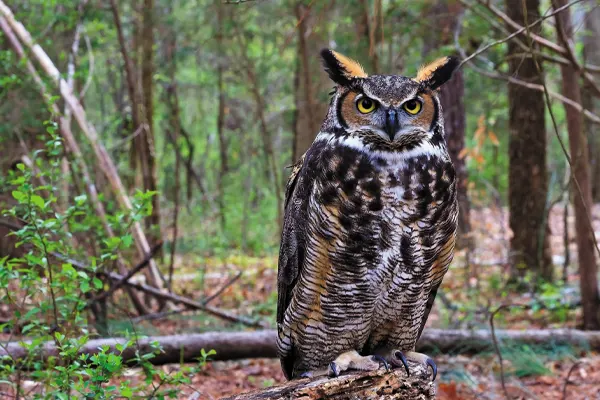
Great Horn Owl
- Lifespan: 5 to 15 years
- Habitat: Diverse environments across North and South America
- Diet: Rabbits, Squirrels, Skunks, Small Birds and even Reptiles and Amphibians.
- Size: 45 to 63 cm
- Weight: 5.5 lbs
- Wingspan: 3.3 to 4.8 Feet
- Conservation Status: Not Globally Considered a Species at risk.
- Population Trend: Generally stable they are not currently facing significant threats to their overall population, although localized declines can occur due to habitat loss and other factors.
The Great Horned Owl is renowned for its distinctive and haunting hooting calls that echo through the night. What makes these calls even more fascinating is the owl’s exceptional hearing adaptations. Unlike humans who have symmetrical ear openings, the owl’s ears are asymmetrically positioned on its head. One ear is slightly higher than the other. This unique ear placement allows the Great Horned Owl to triangulate the source of sounds accurately. When the owl hears a noise, it can determine not only its direction but also its height. This remarkable auditory ability aids the owl in pinpointing the location of potential prey, even in complete darkness.
Species Type
The Great Horned Owl (Bubo virginianus) belongs to the species of true owls known as the “Bubo” genus. Within this genus, the Great Horned Owl is one of the largest and most widespread species. “Bubo” is a diverse genus that includes various other owl species characterized by their large size, prominent ear tufts (or “horns“), and powerful predatory adaptations.

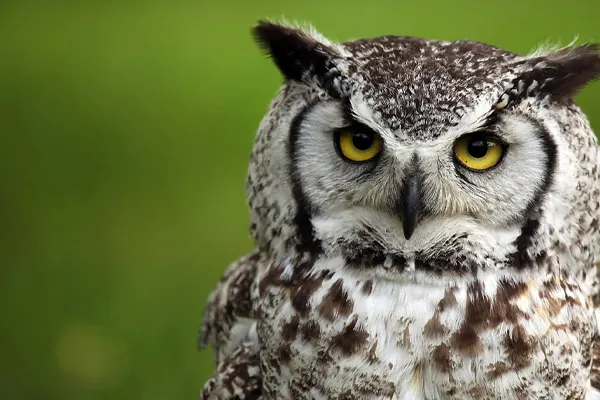
The Great Horned Owl itself is further divided into multiple subspecies, each adapted to the specific environmental conditions of its region. These subspecies may exhibit slight variations in size, plumage coloration, and other characteristics. The overall species, Bubo virginianus, is commonly found throughout the Americas, from the Arctic to South America, showcasing the adaptability of this impressive owl.
Feather Coloration Great Horned Owl
The plumage of the Great Horned Owl is mottled and can vary in color, ranging from dark brown and gray to reddish-brown. This mottled appearance helps the owl blend seamlessly with its surroundings, whether in wooded areas, deserts, or other habitats.
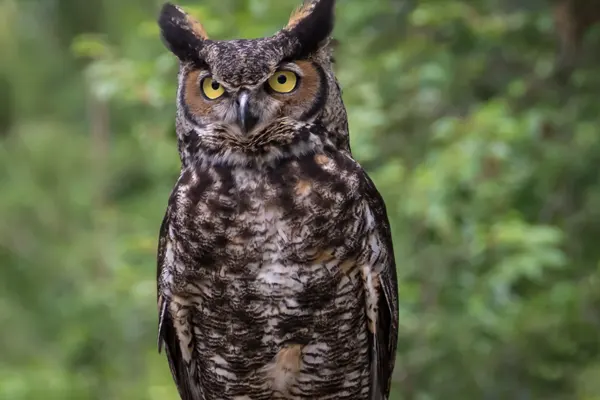
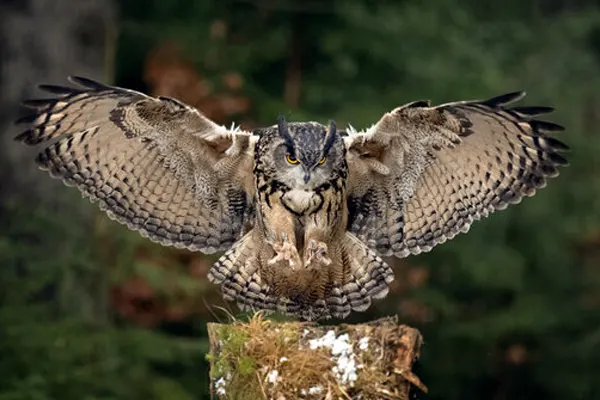
- Facial Disc: The facial disc, a characteristic feature of owls, is typically lighter in color than the rest of the body. It often forms a circular pattern around the owl’s face, creating a frame for its distinctive facial features.
- Ear Tufts: The “horns” or ear tufts on the head are not actually ears but rather feathers. They can vary in length and are usually colored similarly to the surrounding plumage. These tufts are used for communication and can be raised or lowered depending on the owl’s mood.
- Underparts: The underparts of the Great Horned Owl, including the chest and belly, are usually lighter in color, featuring a mix of white, cream, or buff-colored feathers with dark streaks and bars. This pattern helps the owl remain inconspicuous while perched in trees.
- Camouflage Adaptations: The coloration of the Great Horned Owl’s feathers serves as effective camouflage, allowing it to blend into its environment and remain concealed from both prey and predators. This adaptability to various habitats contributes to the owl’s success as a versatile and widespread species.
Flight Characteristics
Great Horned Owls are renowned for their nearly silent flight. Specialized feathers on the leading edges of their wings break up the turbulence that typically creates sound. This adaptation allows them to approach prey stealthily, making them highly effective hunters under the cover of darkness.
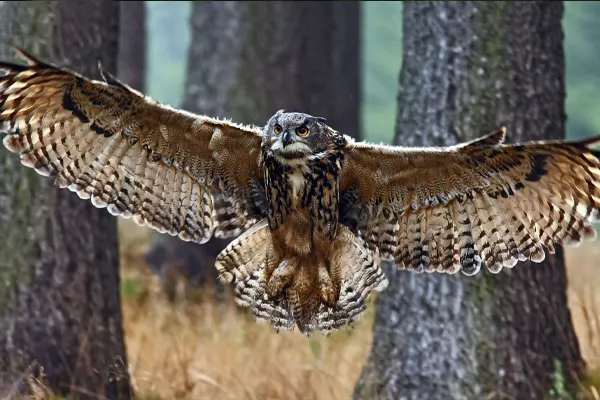
- Powerful and Agile: Despite their large size, Great Horned Owls are powerful and agile fliers. They can cover long distances when searching for prey and navigate through diverse habitats, including forests, open fields, and urban areas.
- Broad Wings and Slow Wingbeats: Great Horned Owls have broad wings that enable them to glide silently through the air. Their flight is characterized by slow, deliberate wingbeats, especially when compared to other raptors. This slow and deliberate flight allows them to maintain control and precision when hunting.
- Adaptability to Various Environments: The Great Horned Owl’s flight is well-adapted to different environments. Whether soaring through wooded areas or gliding over open landscapes, their flight style allows them to effectively hunt a variety of prey, from small mammals to other birds.
- Nocturnal Habits: Great Horned Owls are primarily nocturnal, and their flight is optimized for low-light conditions. Their keen vision and exceptional hearing, coupled with their silent flight, make them well-suited for hunting in the dark.
- Tree-Roosting and Nesting: Great Horned Owls are skilled at navigating through dense vegetation and forests. They often roost in trees and may even nest on large branches or in the abandoned nests of other birds of prey.
Migration Patterns
The Great Horned Owl (Bubo virginianus) is generally not known for long-distance migration in the way some bird species are. They are considered primarily sedentary or non-migratory birds. However, their movements can be influenced by factors such as food availability and environmental conditions. While many Great Horned Owls establish territories and remain in a specific area year-round, some individuals, particularly juveniles, may undertake dispersal movements. These movements involve young owls leaving their natal territories to find new areas to establish their own territories. This can result in owls covering significant distances.

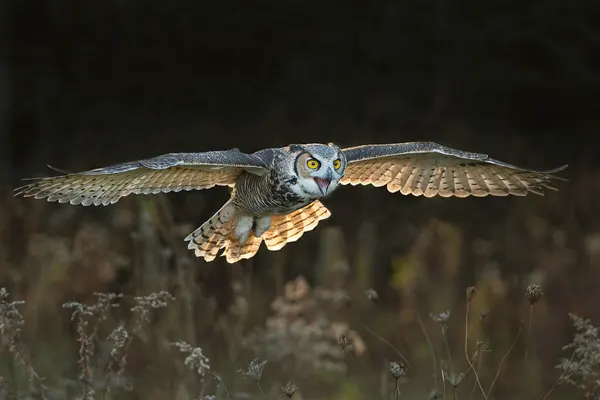
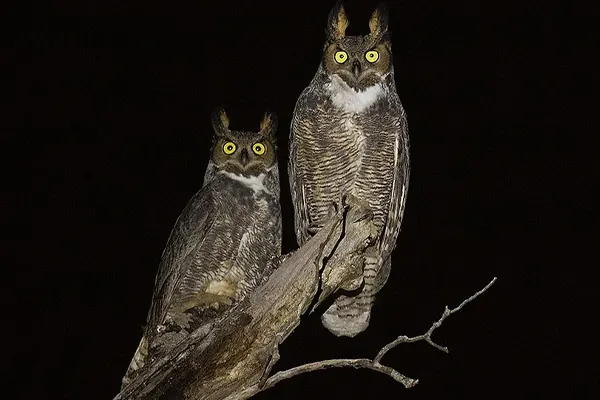
Migration in Great Horned Owls is more about local movements within a region rather than the long-distance seasonal migrations observed in some bird species. They are highly adaptable to different habitats, which contributes to their ability to thrive in a variety of environments without the need for extensive migrations. It’s essential to note that individual owls’ behavior can vary, and some may show more migratory tendencies than others. However, compared to many other bird species, the Great Horned Owl is generally considered a resident bird that maintains a relatively stable home range throughout the year.
Habitat & Distribution
Great horned owls prefer open habitats with trees for nesting and perching. They can be found in forests, woodlands, grasslands, and deserts. They are also found in urban areas, where they prey on rats, mice, and other small mammals.
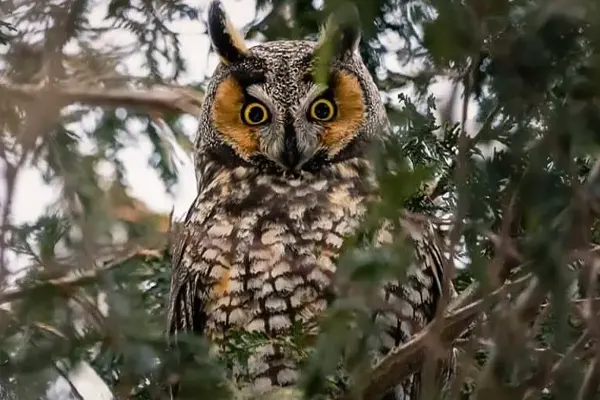
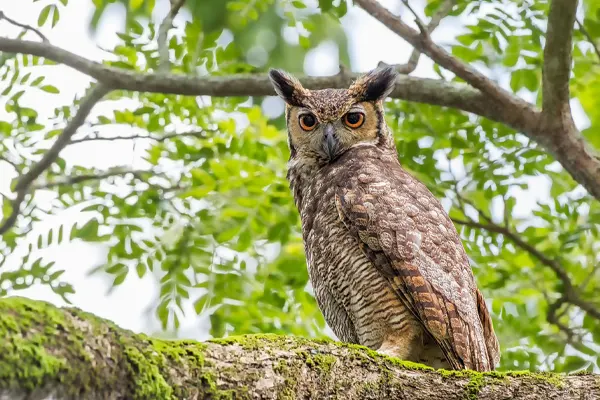
- North and South America: Great Horned Owls have one of the most extensive distributions among North American owls. They are found from the Arctic regions of North America all the way down to the southern regions of South America.
- Range: Their range covers the entire continental United States and extends through Canada, Mexico, and into Central and South America. They are absent only from a few select regions, such as extreme polar areas and certain oceanic islands.
Behavioral Traits
Great Horned Owls are primarily nocturnal, meaning they are most active during the night. Their large eyes are adapted to low light conditions, allowing them to hunt effectively in darkness.
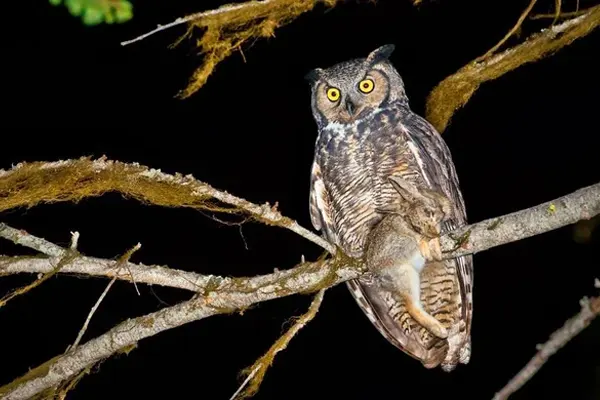

Great Horned Owls are territorial birds, and they establish and defend their territories year-round. These territories can vary in size depending on factors such as habitat and food availability.
Great Horned Owls are known to be aggressive defenders of their nests and territories. They may confront and attack potential threats, including larger predators or humans, to protect their young and maintain their territory.
Role in Ecosystem
The Great Horned Owl (Bubo virginianus) plays a crucial role in the ecosystem as a top predator, influencing various aspects of the food web and contributing to the overall balance of its habitat.

- Predator Control: As an apex predator, the Great Horned Owl helps control the populations of various prey species. By preying on rodents, rabbits, birds, and other small mammals, they help regulate these populations, preventing overgrazing or overpopulation of certain species.
- Population Dynamics: The presence of Great Horned Owls can influence the behavior and population dynamics of their prey. The fear of predation can alter the foraging and reproductive patterns of small mammals and birds, indirectly affecting vegetation and other organisms lower in the food chain.
- Rodent Control: Great Horned Owls are particularly effective at controlling rodent populations. By hunting rodents such as mice and rats, they contribute to the suppression of agricultural pests and help maintain the health of ecosystems by preventing unchecked rodent populations.
- Limiting Mesopredator Populations: The Great Horned Owl’s presence can help limit the populations of mesopredators (medium-sized predators) in the ecosystem. By preying on animals like raccoons and skunks, they prevent these mesopredators from becoming overly abundant and potentially disrupting other parts of the ecosystem.
- Scavenger and Decomposer Contribution: Great Horned Owls may also act as scavengers, consuming carrion when live prey is scarce. This scavenging behavior contributes to the efficient decomposition of animal carcasses, recycling nutrients back into the ecosystem.
Dietary Habits
The Great Horned Owl’s ability to consume a wide variety of prey reflects its adaptability to different habitats. This flexibility in dietary habits contributes to the species’ success in various ecosystems across North and South America.

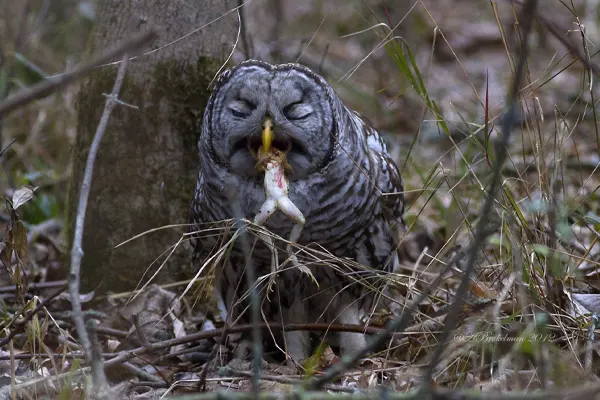
- Rodents: Great Horned Owls are efficient hunters of rodents such as mice, rats, voles, and gophers. These small mammals often form a significant portion of their diet.
- Rabbits and Hares: Larger prey items like rabbits and hares are also commonly taken. The powerful talons and beak of the owl allow it to capture and consume these larger mammals.
- Birds of Various Sizes: Great Horned Owls are versatile hunters of birds, capturing species ranging from small songbirds to larger birds of prey. They may take pigeons, crows, ducks, and even other owls.
- Waterfowl: Near water sources, Great Horned Owls may prey on waterfowl, including ducks and geese.
- Snakes and Lizards: The diet of Great Horned Owls may include snakes and lizards, demonstrating their ability to hunt a variety of reptiles.
- Amphibians: Frogs and toads are also on the menu, especially in habitats with suitable amphibian populations.
- Occasional Fish Consumption: In some cases, Great Horned Owls near water bodies might catch and consume small fish, showcasing their adaptability to different food sources.
Interesting Facts
The Great Horned Owl has one of the most diverse diets among North American raptors, earning it the nickname “Tiger of the Sky.” It preys on mammals, birds, reptiles, and even other owls. With strong talons and a powerful beak, the Great Horned Owl is capable of taking prey larger than itself. It has been known to hunt and consume animals such as skunks and porcupines, which are formidable adversaries.
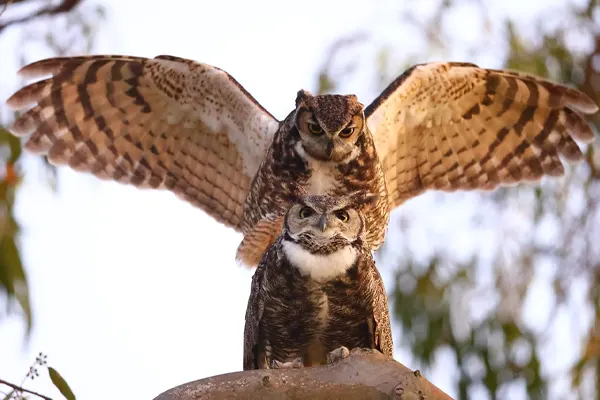
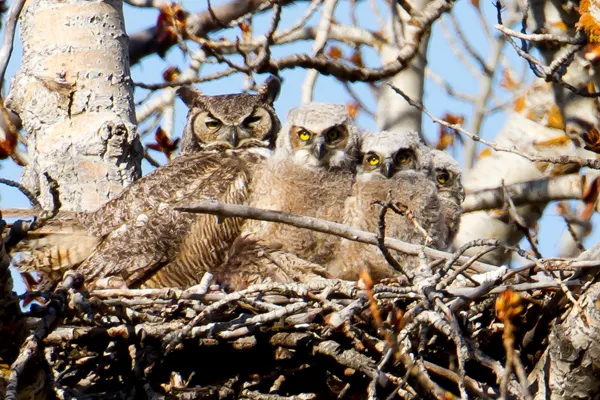
- Parental Dedication: Great Horned Owls are dedicated parents. They often take over existing nests, including those of other large birds, and both parents participate in incubating eggs and caring for the young.
- Large Geographic Range: The Great Horned Owl has one of the widest ranges of any owl species, spanning from the Arctic regions of North America to the southern regions of South America.
- Nocturnal Stealth: Great Horned Owls are known for their nearly silent flight, allowing them to approach prey undetected. Specialized feathers on the leading edge of their wings break up turbulence, minimizing the sound of their wingbeats.
- Cryptic Coloration: The mottled and camouflaged plumage of the Great Horned Owl serves as effective camouflage, helping it blend seamlessly with its surroundings. This cryptic coloration aids in both hunting and avoiding predators.
Nesting Habits
Great Horned Owls are not known for building their nests from scratch. Instead, they typically use existing structures or locations. They may take over abandoned nests of other large birds, such as hawks, crows, or herons, or use natural sites like tree hollows and ledges.
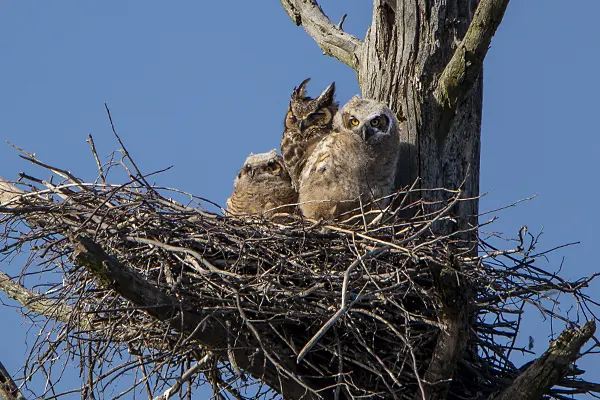
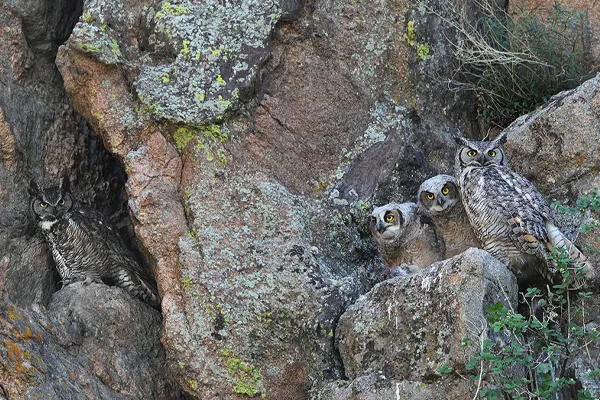
- Tree Nesting: Trees are a common choice for nesting. The owls may use large tree branches, hollows, or broken-off snags for their nests. They show a preference for tall trees that provide a vantage point and easy access for takeoff and landing.
- Cliff Nesting: In some regions, Great Horned Owls nest on cliffs, especially when suitable trees are scarce. They may use natural rock crevices or ledges for their nests in cliff habitats.
- Nesting in Urban Areas: Great Horned Owls have shown adaptability to human-altered landscapes. They may choose to nest in urban and suburban areas, utilizing trees in parks or even ledges on buildings. This adaptability to human environments contributes to their widespread distribution.
- Stick Arrangement: While they do not construct intricate nests, Great Horned Owls often arrange sticks, leaves, and other materials to create a basic platform within the chosen nest site. The female may add her down feathers as lining.
- Year-Round Nesting: Great Horned Owls are known for their early nesting habits. In many regions, they may start nesting in the heart of winter. This early nesting allows them to take advantage of the availability of prey when other birds are not actively breeding.
Calls & Vocalizations
The vocal repertoire of the Great Horned Owl is diverse and serves various communication purposes, from territory establishment to courtship and defense. These vocalizations play a crucial role in the social dynamics and behaviors of these impressive birds of prey.

- Aggressive Calls: When threatened or disturbed, Great Horned Owls may emit a series of aggressive calls. These can include hissing sounds, bill snapping, and clacking noises, serving as a warning to potential threats.
- Screeches and Whistles: In addition to hooting, Great Horned Owls can produce screeching and whistling sounds. These calls are often used in different contexts, including communication between mates, interactions with offspring, or expressing agitation.
- Barks and Growls: Great Horned Owls are capable of producing barking and growling sounds, especially during confrontations with intruders. These vocalizations can be part of territorial disputes or interactions with other birds of prey.
- Chirps and Begging Calls: Young owlets produce high-pitched chirps and begging calls when requesting food from their parents. These calls are distinct from the deeper hoots of adults and serve to communicate hunger and need for attention.
- Mimicry: Great Horned Owls are known to mimic the calls of other birds, animals, or even sirens. This mimicry can be part of their communication strategy, and they may use it to confuse potential threats or to lure prey within striking range.
Ecological Significance
The Great Horned Owl plays a critical role in shaping and maintaining the ecological balance of the ecosystems it inhabits. As a keystone species and apex predator, its presence influences the dynamics of populations throughout the food web, contributing to the overall health and functioning of the ecosystem.
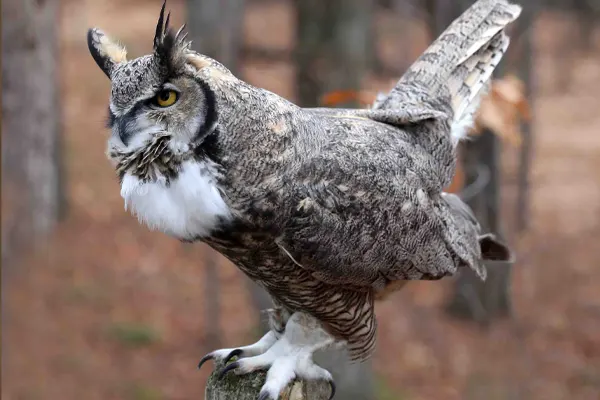
- Population Control: As an apex predator, the Great Horned Owl helps control the populations of numerous species in its environment. By preying on rodents, rabbits, and other small mammals, it regulates their numbers, preventing overgrazing and maintaining a balance within the ecosystem.
- Mesopredator Regulation: Great Horned Owls also play a role in regulating the populations of mesopredators (medium-sized predators). By preying on animals like raccoons, skunks, and opossums, they prevent these mesopredators from becoming overly abundant and disrupting the balance of the ecosystem.
- Bird and Reptile Regulation: The owl’s predation on birds and reptiles contributes to the control of their populations. This predation can influence the behavior, distribution, and abundance of various bird and reptile species within the ecosystem.
- Cascading Effects: The presence of Great Horned Owls can have cascading effects on lower trophic levels. For example, their predation on rabbits and rodents may influence vegetation dynamics and impact other herbivores dependent on those plants.
- Carrion Consumption: Great Horned Owls, as opportunistic scavengers, help recycle nutrients in ecosystems by consuming carrion. Their role in cleaning up carcasses contributes to nutrient cycling and supports overall ecosystem health.
- Biodiversity Maintenance: By influencing the populations of various prey species, Great Horned Owls contribute to the maintenance of biodiversity. Their predation prevents the dominance of certain species, allowing for a more diverse array of organisms to coexist in the ecosystem.
Conservation Status
The Great Horned Owl (Bubo virginianus) is not globally considered a species at risk, and it is categorized as a species of “Least Concern” by the International Union for Conservation of Nature (IUCN). The “Least Concern” designation implies that the species has a widespread and relatively stable population.
However, it’s important to note that the conservation status of a species can vary regionally, and local populations may face specific threats. Common factors that can affect owl populations include habitat loss, human disturbance, and exposure to pesticides or other environmental contaminants.
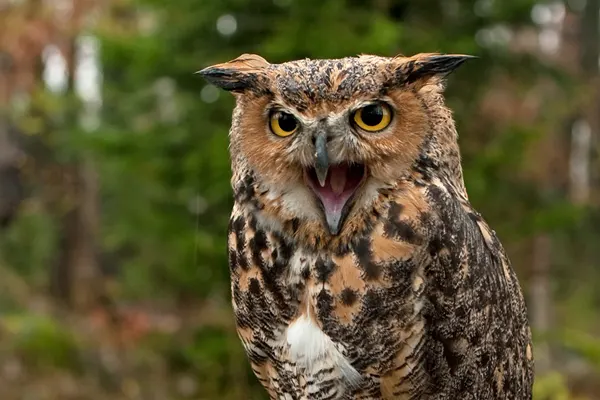
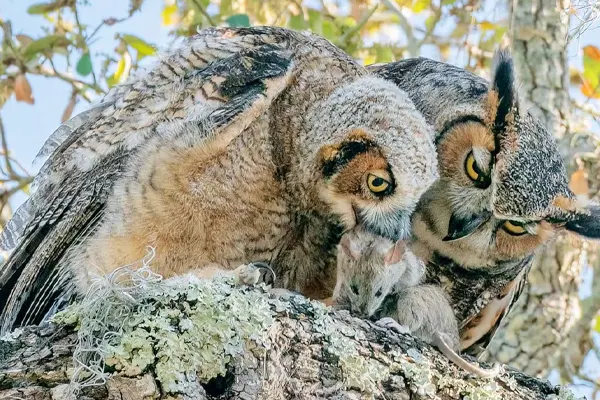
Conservation efforts often focus on preserving suitable habitats, raising awareness about the ecological importance of owls, and addressing specific threats such as poisoning or collisions with human-made structures. Local wildlife management authorities and organizations may implement measures to protect nesting sites and ensure the conservation of prey species.
Research and Ongoing Studies
Research on the Great Horned Owl (Bubo virginianus) encompasses various aspects of its biology, behavior, ecology, and conservation. Ongoing studies contribute to a deeper understanding of this species and its interactions within ecosystems.
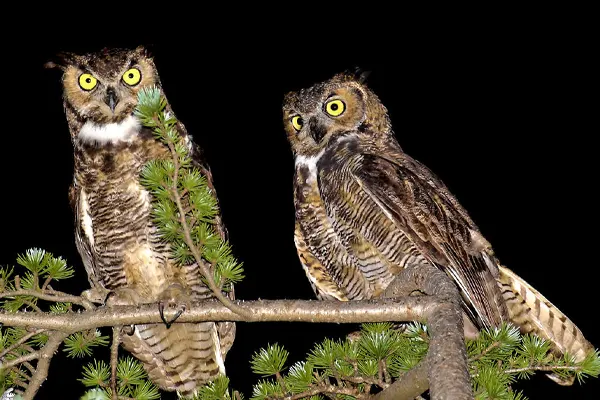
- Dietary Ecology: Research explores the dietary habits and foraging ecology of Great Horned Owls, investigating the impact of prey availability on their reproductive success and population dynamics. This information is crucial for assessing their role in controlling prey populations.
- Genetics and Population Genetics: Genetic studies help determine the genetic diversity and population structure of Great Horned Owl populations. This information aids in conservation efforts and understanding the connectivity between different populations.
- Migration and Dispersal: While Great Horned Owls are generally considered non-migratory, ongoing studies may investigate the movement patterns of certain individuals, especially juveniles, to understand dispersal behaviors and connectivity between different regions.
- Health and Disease: Research assesses the health of Great Horned Owl populations, including studies on diseases, parasites, and environmental contaminants. Monitoring health is critical for assessing the overall well-being of the species.
Educational and Ecotourism Opportunities
The Great Horned Owl (Bubo virginianus) presents various educational and ecotourism opportunities, offering a chance for people to learn about these magnificent birds of prey and their role in ecosystems. Incorporating Great Horned Owls into school curricular and environmental education programs can enhance students’ understanding of local ecosystems, food webs, and the importance of biodiversity.
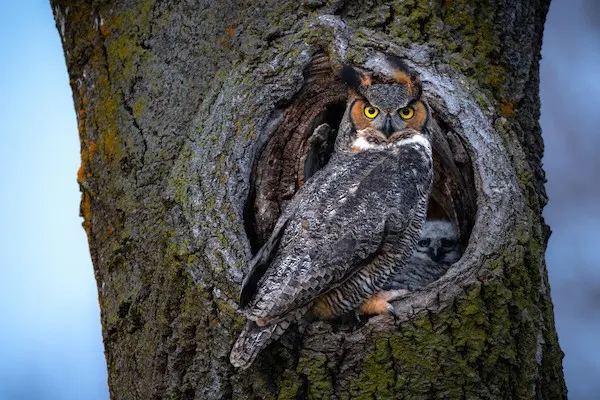
- Behavior and Vocalizations: Studies focus on the intricate vocalizations and behavior of Great Horned Owls, including courtship rituals, territorial calls, and communication between mates. Understanding their vocal repertoire aids in deciphering social dynamics and breeding behaviors.
- Dietary Ecology: Research explores the dietary habits and foraging ecology of Great Horned Owls, investigating the impact of prey availability on their reproductive success and population dynamics. This information is crucial for assessing their role in controlling prey populations.
- Genetics and Population Genetics: Genetic studies help determine the genetic diversity and population structure of Great Horned Owl populations. This information aids in conservation efforts and understanding the connectivity between different populations.
- Migration and Dispersal: While Great Horned Owls are generally considered non-migratory, ongoing studies may investigate the movement patterns of certain individuals, especially juveniles, to understand dispersal behaviors and connectivity between different regions.
- Health and Disease: Research assesses the health of Great Horned Owl populations, including studies on diseases, parasites, and environmental contaminants. Monitoring health is critical for assessing the overall well-being of the species.
Conclusion
The Great Horned Owl (Bubo virginianus) stands as a remarkable and adaptable species, embodying the qualities that have enabled it to thrive across diverse ecosystems in the Americas. With its distinctive hooting calls, silent flight, and powerful predatory skills, the Great Horned Owl holds a prominent place as an apex predator in various habitats.
Noteworthy for its versatility, this owl has demonstrated a capacity to inhabit environments ranging from dense forests to urban landscapes, showcasing its ability to adapt to changing ecosystems influenced by human activities. Its cryptic plumage, coupled with its territorial and nesting behaviors, further exemplifies the species’ strategies for survival and successful reproduction.
Beyond its ecological significance as a top predator, the Great Horned Owl plays a vital role in maintaining the balance of ecosystems by regulating populations of rodents, birds, and other prey species. As a subject of ongoing research, these owls contribute valuable insights into avian behavior, genetics, and ecological dynamics.



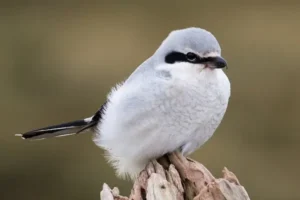

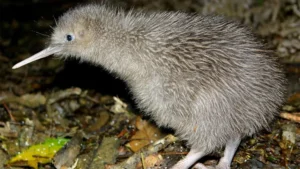



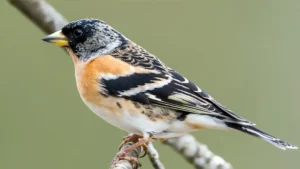


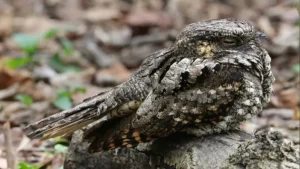
Leave your comment